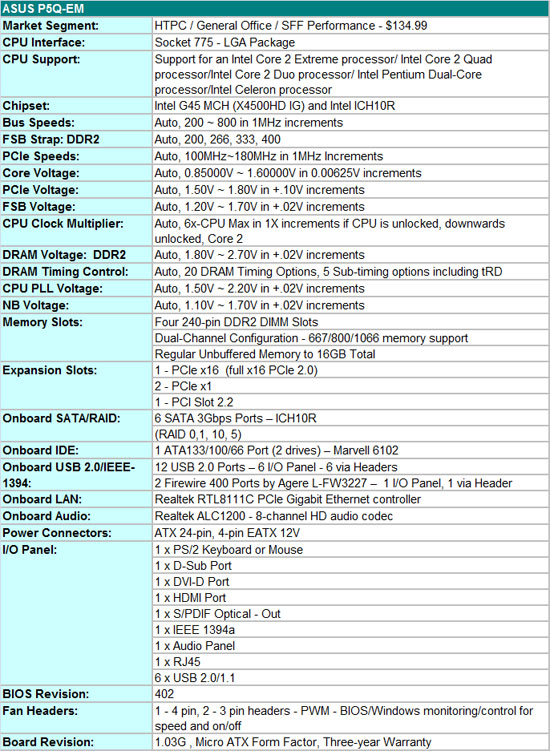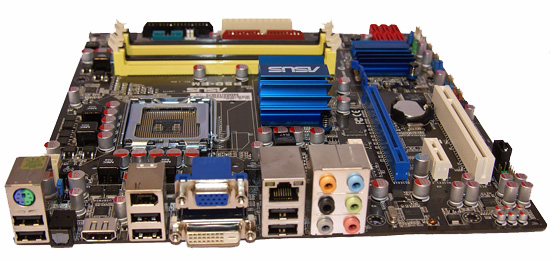The IGP Chronicles Part 1: Intel's G45 & Motherboard Roundup
by Anand Lal Shimpi & Gary Key on September 24, 2008 12:00 PM EST- Posted in
- Motherboards
ASUS P5Q-EM
Our first board up is the ASUS P5Q-EM, which is a worthy successor to the G35 based P5E-VM HDMI. In addition to being the first board that we discuss today, it also happens to be our favorite “all around” board. All four of our boards perform almost identically when it comes to high-definition playback and they all score similarly in our IG based tests. However, if you want a uATX board for your SFF gaming system or plan on overclocking then the ASUS board is a logical choice. Of course, our uATX P45 based DFI P45-T2RS Jr might disagree, but that is a discussion for another time.

In the meantime, the P5Q-EM is a feature rich G45 board featuring an OC friendly BIOS, Gigabit LAN via the almost universal Realtek RTL8111C, IEEE 1394a support, full RAID support along with six SATA ports via the ICH10R, PATA support comes by way of the Marvell 6102, and HD audio via the Realtek ALC1200. Think of the ALC1200 as being the same chipset used by Gigabyte this past year, the ALC889a. However, ASUS does not provide DTS Live and Dolby Home Theater capabilities that Gigabyte does although we understand ASUS is working with DTS on an upgrade. However, one of the main attributes for purchasing a G45 based board is for the multi-channel LPCM output capabilities.
ASUS also provides their Express Gate technology that allows you to access the internet or utilize the most popular IM programs without booting into the OS. Also featured is their EPU-4 engine that provides additional power savings by detecting load conditions and adjusting power in real time. We will have a dedicated look at ASUS' EPU, DES from Gigabyte, and DrMOS from MSI shortly. In the meantime, we were able to save a few watts at various times over the traditional C1E/Speedstep BIOS settings. Fan control and monitoring is good with the capability to set fan speeds based upon thermal conditions in the BIOS or Windows.

In our opinion, ASUS provided an excellent layout considering the space limitations on a Micro ATX board. If the board is utilized in a SFF gaming system, the user is still left with a free PCIe x1 and PCI slot when using a dual slot video card. The heatsink designs did not interfere with a variety of peripherals that we installed including several popular CPU fan/heatsinks and video cards. We have noticed the G45 MCH running a little hot at times but the heatsink design from ASUS was more than capable during testing. We are still waiting for the official death of the floppy drive (and soon the IDE port but we still see value in IDE for a little longer) so the area where these connectors are located can be reclaimed.
ASUS utilizes an excellent four-phase power delivery system along with decent solid capacitors throughout the board that resulted in very stable operation with everything from a Q9650 down to a heavily overclocked E2180. The inclusion of a PS/2 combo port for either a keyboard or mouse is a nice touch for now as we see most suppliers dropping PS/2 support shortly. Other niceties included output support for VGA, HDMI, or DVI-D along with a Firewire port on the IO panel. Overall, the layout is clean, unobtrusive, and will work well for a vast majority of owners.
Pros/Cons
We have to be honest here, up until BIOS 0402, we were not that enamored with this board from an enthusiast's viewpoint. Sure, the basic functionality was there and all peripherals worked fine for a HTPC setup, but the board was not living up to its BIOS options. While this is not important for the vast majority of users looking at IG boards, it is important for users who will use this board as a crossover for a performance oriented SFF system. Our problems ranged from lack of support for the E8600 and Q8200 processors to 8GB compatibility under Vista 64. Additional problems were incurred when overclocking the system as we consistently hit a wall around 415FSB with a 4GB configuration and VCore tended to undervolt severely when set above 1.45V, although with the newer EO steppings you should not have a need for volts that high. Fortunately, most of our performance problems have been solved including overlcocking with memory ratios other than 1:1.
While still not perfect, we were able to attain 455FSB with our Q9300 and 485FSB with the E8600 with aggressive timings, a discreet video card, and 4GB. We are not going to show in-depth overclocking results in today's article since it is oriented towards the chipset introduction with intended use for an office or media application platform. However, if you need an uATX board that offers very good overclocking performance for mainstream users, this board will not disappoint with a discreet video card. We hit a 412FSB wall with the integrated graphics set, not bad at all actually. While video performance is not improved, it is a good way to improve encoding performance with a lower speed processor.
Moving on to more important items for most of us, except for driver, strict EDID adherances, and BD playback problems that are the responsibility of Intel, this board performed admirably throughout IG testing. In our particular setups, we did not have any real problems except for 8GB compatibility under Vista 64 up until BIOS 0402. That said, we think ASUS made a mistake not including an eSATA port on the IO panel. We are also not fans of VGA output or continuing with floppy drive support in this market segment. Both choices would likely be viable options for certain business environments, but we do not see their usefulness in this particular target market. The board worked perfectly when resuming from an S3 state and consistently outperformed the other boards in time to desktop measurements.
While we like the combo PS/2 mouse/keyboard port since it is better than none (yes, we still like the PS/2 keyboard port when overclocking or changing BIOS settings), users with certain wireless keyboard/mouse setups will have to think about upgrading. In fact, PS/2 port availability is something we openly debate, some openly love their inclusion, and some of us just wish we would finally get rid of the legacy ports. We would not have minded a coaxial SPDIF port or IR capability either. Overall, the feature set is impressive for a uATX board and if we only had one wish, it would be adding an eSATA port to the rear IO panel. To reiterate our opinion about this board, if you need a uATX board with versatility then we think this is the board for you.















53 Comments
View All Comments
Butterbean - Wednesday, September 24, 2008 - link
I'm not sure why this board is measured/reviewed for its gaming ability (or lack of). A lot of HTPC peeps get these because they are quiet and can play DVD's without the noise /heat. Not many people really expect to play Oblivion on it.8steve8 - Wednesday, September 24, 2008 - link
the dg45id has the unique ability to ouptut simultaniously to two displays with a digital interface.imo its the prefect board for non-gamers with dual-monitors..
seriouosly.. analog sucks.
should be listed in the pros/cons.
CSMR - Wednesday, September 24, 2008 - link
Yes, a very important feature for a work system with integrated graphics. Presumably common to all G45 boards with DVI and hdmi?yehuda - Saturday, September 27, 2008 - link
No, the Gigabyte board can't do that even though it has both ports.http://download.gigabyte.ru/manual/motherboard_man...">http://download.gigabyte.ru/manual/motherboard_man... (p. 8, footnote 1)
npp - Wednesday, September 24, 2008 - link
SPCR measured the power consumtion of the same mini-ITX G45 board and found it to consume 35W at idle with an E7200 CPU installed (which should consume a tiny bit more than a 5200, given it works at higher FSB speeds and has more cache).Your figures showed something like 57W; one would say, hey, no big deal, we're talking about only 22W here. But if you take this as relative difference - it turns out to be 60%! SPCR used only one DIMM, but I doubt this can explain the discrepancy. The PSU was a 400W model, so I guess it has similar efficiency curve as the Corsair model you used.
Given the strange results of you power consumption measurements recently, I have reasons to doubt that something simply isn't right out there.
CSMR - Wednesday, September 24, 2008 - link
SPCR people will make more efficient choices. Efficient PSU, notebook hard drive, non-overclocked RAM. 57W is a good result for a mainstream review. Little things can add up to 22W, especially PSU efficiency.MadDogMorgan - Wednesday, September 24, 2008 - link
ANAND! These vibrant media popups are KILLING ME!!!!I am about ready to GO INSANE reading your site. You CAN'T POSSIBLY be making any MONEY off those things, they are too INCREDIBLY ANNOYING for anyone to ever THINK about watching one or clicking one.
Oh, and I LIKE PS/2 ports. What's wrong with PS/2 ? It works great, takes less cpu than USB (in my VERY informal mouse testing) and the headers take up very little space on the mobo. You also have the option to use the USB connections instead, if you want.
Anand Lal Shimpi - Wednesday, September 24, 2008 - link
Visit this URL: http://anandtech.com/siteinfo.aspx?off=yes">http://anandtech.com/siteinfo.aspx?off=yesIt'll disable all IntelliTXT on AnandTech for you :)
-A
zagood - Wednesday, September 24, 2008 - link
Wow, thank you! Now how do we do that on DT?MadDogMorgan - Wednesday, September 24, 2008 - link
Thank you VERY MUCH for providing this option.Also, please keep up the good work and I appreciate you spending some time in the HTPC area. It seems to me there is a decided lack of good technical coverage in this arena. The kind of in-depth coverage that only your and a couple of other notable sites provide.
I would like to see some TV Tuner card reviews from your site comparing the technical details of the latest offerings from Hauppauge, ATI and any other popular ones. Toss in a review of a few PVR apps like GB-PVR, SageTV, MythTV and BeyondTV and (HTPC) life would be complete. Don't forge to address the difficulty of getting the channel listings when using a freebe like GB-PVR, or the ins and outs of getting scheduled recordings to actually WORK when the app uses the Windows Task Scheduler.
Thanks Again.